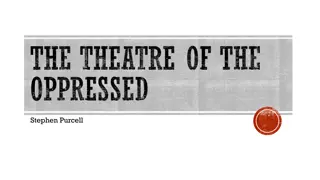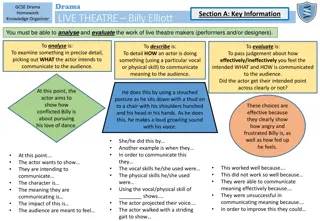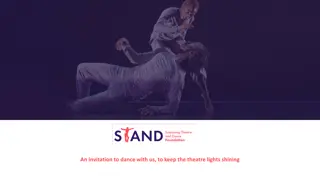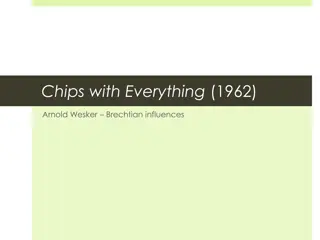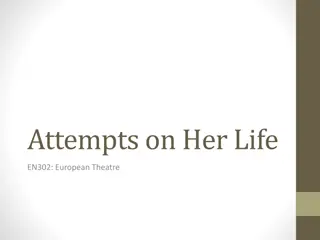Theatre Essentials: Understanding Acting, Ensembleness, and More
Dive into the fundamental aspects of theatre, exploring topics such as the definition of theatre, the importance of ensemble work, acting principles, and the concept of ensembleness. Discover how theatre reflects real life, the parallels it shares with sports, and the rules actors abide by. Gain insights into audience roles, actor responsibilities, and the significance of trust and teamwork in creating a successful performance.
Download Presentation

Please find below an Image/Link to download the presentation.
The content on the website is provided AS IS for your information and personal use only. It may not be sold, licensed, or shared on other websites without obtaining consent from the author.If you encounter any issues during the download, it is possible that the publisher has removed the file from their server.
You are allowed to download the files provided on this website for personal or commercial use, subject to the condition that they are used lawfully. All files are the property of their respective owners.
The content on the website is provided AS IS for your information and personal use only. It may not be sold, licensed, or shared on other websites without obtaining consent from the author.
E N D
Presentation Transcript
ESSENTIAL QUESTIONS What is theatre? What does it mean to be part of an ensemble? In what ways does etiquette apply for an actor or audience member?
What is THEATRE? OUR EXPRESSION _ because it is a product of __ _ , ART Theatre is ____ __ by others. INTERPRETED in which it can be Theatre is both a ___________expression (actors, audience, playwright) and a PERSONAL _________expression (technicians / artists) VISUAL Theatre becomes art when ________________________________ IT IS ACTED OUT FOR AN AUDIENCE
Theatre has many similarities to playing sports or games. Audience is to ____________ SPECTATORS Stage is to ____________ FIELD Costumes is to ____________ UNIFORMS ____________ DIRECTOR is to Coach ____________ ACTORS is to Players ____________ PROPS is to Equipment ____________ SCRIPT is to Playbook
ACTING The GOAL of acting is to ___________________ in a manner or SOLVE A PROBLEM way in which the audience can understand, accept and become emotionally involved. TO ACT MEANS TO ____ SHOW, DON T _______ DO TELL ABOVE ALL, remember that ________________________________________________ THEATRE IS A REFLECTION OF REAL LIFE!
RULES of acting: TO DO ___________________ (TO BE PHYSICALLY INVOLVED) 1. _____________ 2. _____________ TO THINK TO BE AWARE ___________________ (TO BE MENTALLY INVOLVED) 3. _____________ ___________________ (TO BE FOCUSED-STAY IN CHARACTER) 4. ________________________ TO HAVE ENSEMBLENESS (TO HAVE TEAMWORK) _________________ UNDERSTAND The ACTOR S JOB is to get the audience to _______________, ____________ , & to ______________ BELIEVE RESPOND ATTENTIVE The AUDIENCE S JOB is to be ____________, to ________________ , & to ____________ . UNDERSTAND RESPOND
What is ENSEMBLENESS? Ensembleness is _____________ . Actors____________________ TEAMWORK WORK TOGETHER to solve the problem of the scene. TRUST Ensemblenessrequires each actor to rely on _______ , __________ , and _________________ from each other. SUPPORT COOPERATION YOURSELF TRUSTING _________ will foster self-confidence and allow you to improvise freely. OTHERS TRUSTING _________ will result in a creative, safe working environment. - There is nothing quite so frightening as being onstage with an actor who has broken your trust.
Good ENSEMBLENESS will allow actors to _______ and _______ on stage together. GIVE TAKE In order to GIVE and TAKE on stage actors should: 1. _________________ USE EYE CONTACT 2. _________________ LISTEN TO OTHERS 3. _________________ SHARE THE STAGE If you are not working together, then you are working againstone another
What is IMPROVISATION? Improvisation is ______________________________. ACTING ON THE SPUR-OF-THE MOMENT 1. ________________ TO ENTERTAIN PURPOSE of Improvisation: STRUCTURE of Improvisation: BEGINNING 2. __________________________ TO STRENGTHEN ACTOR SKILLS 2. ________ 3. _________ MIDDLE END 1.________ 4. ________ WHO 5. ________ WHAT 6. ________ WHERE Resolve the conflict Develop the conflict 7. ________ ________ _______ CONFLICT
REQUIREMENTS / GUIDELINES of Improvisation: 1. _______________________________ NO SCRIPT 2. _______________________________ 2+ CHARACTERS COMPLETE STRUCTURE 3. _______________________________ 4. _______________________________ LIMITED PREPLANNING CONDUCT / BEHAVIOR of Improvisation: ALWAYS GIVE AND TAKE - RESPECT 1. ___________________________________ ABSOLUTELY NO BROWN BAGGING 2. ___________________________________
PERFORMANCE PROCEDURE _______________ - moment before starting WARNING 1. This is the cue for the actors and audience to get focused. Audience: face forward, feet off chairs, sit up straight & quiet Actors: Stage is set, actors set on/off stage, & quiet CURTAIN 2. _______________ - the beginning of the action ONE actor from the group will call curtain which signals the scene is beginning. FREEZE 3. ________________ - the end of the action ONE actor from the group will call freeze which signals the scene is over.
Oral critiques 1. GIVE POSITIVE FEEDBACK Remember that everyone needs positive reinforcement. Praise one or two things that the speaker or performer did well.... BE HONEST. Be specific! Talk directly to the actor! I liked the voice you chose for your character. It really sounded like an cranky old man. Good job! I really believed you were a little toddler! Your actions, voice and movement looked like a little child!
Oral critiques 2. GIVE CONSTRUCTIVE CRITICISM Try to avoid overwhelming the speaker or performer by identifying everything that you think he/she did wrong. Give only one or two criticisms. Suggest Improvements! Be Specific! Talk directly to the actor! When you had the split scene, it was very difficult to hear what was going on. Maybe have one group freeze while the other performs so we can hear them, then return to the other action.


